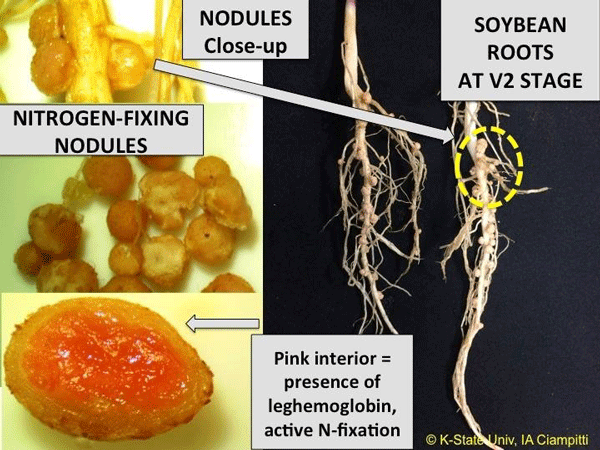If soybean plants are chlorotic (yellow) and nitrogen (N) deficient despite being inoculated, that probably indicates the inoculant has failed.
Assessing nodulation in the field
In the field, nodules from some soybean plants can be crushed to assess their internal color. In general, a pink or reddish internal color indicates the rhizobia is actively fixing N. On the other hand, a dark gray or whitish color indicates the rhizobia is not effectively fixing N. This color will be difficult to see in very young or very old nodules. Nitrogen fixation slows down, and nodules begin to senesce (deteriorate) during seed fill as the plant directs most of its resources to reproduction.

Figure 1. Close-up of soybean nitrogen-fixing nodules. Photos by Ignacio Ciampitti, K-State Research and Extension.
What factors affect inoculation response?
Several factors can result in poor nodulation or failure of inoculation:
- Poor or inadequate coverage of the seeds by the inoculum during inoculation.
- Contamination of inoculant with foreign materials.
- Lack of competitiveness of the introduced Rhizobia strain compared to the indigenous Rhizobia.
- Lack of persistence in the soil: The introduced Rhizobia should be able to grow and remain viable in the soil and in between crops without undergoing mutation.
- Low soil phosphorus (P): Legumes need adequate P for proper growth and pod development. Low P can result in poor nodulation and reduced N fixation. Phosphorus deficiency can negatively affect seed development and pod formation leading to low yield.
- Soil pH: This is an important environmental factor. Most legumes grow and nodulate well at pH 5.6 to 6.7. The best soil pH for Rhizobium lies between pH 6 to 7. Low pH soils require liming. In general, legume responds well to liming. Low pH (< 5) causes aluminum (Al) and manganese (Mn) toxicity, and results in P deficiency.
- Soil nitrate and ammonium levels: High inorganic N (ammonium and nitrate) levels in the soil inhibit nodulation and N fixation. The effectiveness and competitiveness of Rhizobia are negatively affected by high inorganic nitrogen.
- Molybdenum (Mo): Soils deficient in Mo can have reduced nitrogen fixation. Mo, an essential micronutrient, is needed for the formation and function of the nitrogenase enzymes. Legumes also need other micronutrients such as iron, boron, and copper.
- Stress, either in the form of drought, excessive soil moisture, and high temperatures can reduce nodulation.
If the inoculation has failed, producers may need to apply N to their soybean crop. Depending on the projected yield potential, producers may need to apply as much as 120-180 lbs N/acre.





